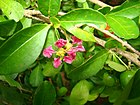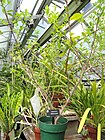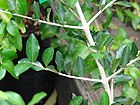Note: This is a project under development. The articles on this wiki are just being initiated and broadly incomplete. You can Help creating new pages.
Difference between revisions of "Malpighia emarginata - Acerola"
(→External Links) |
|||
| (20 intermediate revisions by 2 users not shown) | |||
| Line 1: | Line 1: | ||
| − | |||
[[File:Malpighia glabra blossom and unripe fruits.jpg|thumb|right|''Malpighia emarginata'']] | [[File:Malpighia glabra blossom and unripe fruits.jpg|thumb|right|''Malpighia emarginata'']] | ||
| − | '''Malpighia emarginata''' is a tropical fruit-bearing shrub or small tree in the family Malpighiaceae. Acerola is native to South America, southern Mexico, Puerto Rico, Brazil, and Central America | + | '''Malpighia emarginata''' is a tropical fruit-bearing shrub or small tree in the family Malpighiaceae. Acerola is native to South America, southern Mexico, Puerto Rico, Brazil, and Central America. |
==Uses== | ==Uses== | ||
| − | {{Uses| | + | {{Uses|Scurvy}}, {{Uses|Diabetes}}, {{Uses|Cancer prevention}}, {{Uses|Anti aging action}}, {{Uses|Metabolic disorders}}, {{Uses|Heart problems}}, {{Uses|Digestion}}<ref name="Karnataka Medicinal Plants"/> |
==Parts Used== | ==Parts Used== | ||
| − | {{Parts Used| | + | {{Parts Used|Fruits}}<ref name="Karnataka Medicinal Plants"/> |
==Chemical Composition== | ==Chemical Composition== | ||
| − | + | Acerola provides a rich source of vitamin C, about 1000 to 4000 mg per 100 grams. The green, unripe fruits contain twice the amount of Vitamin C than the ripe fruits.<ref name="chemical composition"/> | |
==Common names== | ==Common names== | ||
| − | {{Common names|kn=|ml=|sa=|ta=|te=|hi=|en=Barbados Cherry}} | + | {{Common names|kn=Sime Arenelli|ml=|sa=|ta=|te=|hi=|en=Barbados Cherry}} |
==Properties== | ==Properties== | ||
| Line 38: | Line 37: | ||
==Identification== | ==Identification== | ||
===Leaf=== | ===Leaf=== | ||
| − | {{Leaf|Simple||The leaves are divided into 3-6 toothed leaflets, with smaller leaflets in between}}<ref name="Leaf"/> | + | {{Leaf|Simple|Ovate-lanceolate|The leaves are divided into 3-6 toothed leaflets, with smaller leaflets in between}}<ref name="Leaf"/> |
===Flower=== | ===Flower=== | ||
| − | {{Flower|Unisexual|2-4cm long|Yellow|5- | + | {{Flower|Unisexual|2-4cm long|Yellow|5-10|The flowers are sessile and borne on the short-peduncled cymes. Flowering season is May - November}} |
===Fruit=== | ===Fruit=== | ||
| − | {{Fruit|| | + | {{Fruit|The fruit is very long and narrow|Pointed at both ends|It contains thin flat seeds||Many|Fruiting season is May - November}} |
===Other features=== | ===Other features=== | ||
==List of Ayurvedic medicine in which the herb is used== | ==List of Ayurvedic medicine in which the herb is used== | ||
| − | |||
==Where to get the saplings== | ==Where to get the saplings== | ||
| Line 59: | Line 57: | ||
==Commonly seen growing in areas== | ==Commonly seen growing in areas== | ||
| − | {{Commonly seen| | + | {{Commonly seen|Subtropical area}}, {{Commonly seen|Meadows}}, {{Commonly seen|Borders of forests and fields}}. |
==Photo Gallery== | ==Photo Gallery== | ||
<gallery class="left" caption="" widths="140px" heights="140px"> | <gallery class="left" caption="" widths="140px" heights="140px"> | ||
| − | + | ||
| − | + | Acerola-florDSC7554.jpg | |
| − | + | ||
| + | Acerola.JPG | ||
| + | |||
| + | |||
| + | Flor de acerola2.JPG | ||
| + | |||
| + | |||
| + | Malpighia emarginata - Wellesley College - DSC09764.JPG | ||
| + | |||
| + | |||
| + | Starr 070906-8593 Malpighia emarginata.jpg | ||
| + | |||
| + | |||
| + | Starr 070906-8594 Malpighia emarginata.jpg | ||
| + | |||
| + | |||
| + | Starr 070906-8595 Malpighia emarginata.jpg | ||
| + | |||
| + | |||
| + | Starr 071024-0467 Malpighia emarginata.jpg | ||
| + | |||
</gallery> | </gallery> | ||
| Line 71: | Line 89: | ||
<references> | <references> | ||
| − | <ref name="chemical composition">[https://www. | + | <ref name="chemical composition">[https://www.ayurtimes.com/acerola-barbados-cherry-malpighia-emarginata/ Phytochemistry]</ref> |
| + | |||
| + | <ref name="Leaf">[https://www.ayurtimes.com/acerola-barbados-cherry-malpighia-emarginata/ Plant description]</ref> | ||
| + | |||
| + | <ref name="How to plant/cultivate">[http://tropical.theferns.info/viewtropical.php?id=Malpighia+emarginata Cultivation Details]</ref> | ||
| − | <ref name=" | + | <ref name="Karnataka Medicinal Plants">"Karnataka Medicinal Plants Volume - 2" by Dr.M. R. Gurudeva, Page No.456, Published by Divyachandra Prakashana, #45, Paapannana Tota, 1st Main road, Basaveshwara Nagara, Bengaluru. </ref> |
| − | |||
</references> | </references> | ||
==External Links== | ==External Links== | ||
| − | * [http://gardenoracle.com/images/malpighia-emarginata.html | + | * [http://gardenoracle.com/images/malpighia-emarginata.html Garden oracle.com] |
* [http://www.madaboutberries.com/acerola.html How to Grow Acerola Cherries] | * [http://www.madaboutberries.com/acerola.html How to Grow Acerola Cherries] | ||
* [https://www.pfaf.org/user/Plant.aspx?LatinName=Malpighia+emarginata Malpighia emarginata on plants for future] | * [https://www.pfaf.org/user/Plant.aspx?LatinName=Malpighia+emarginata Malpighia emarginata on plants for future] | ||
[[Category:Herbs]] | [[Category:Herbs]] | ||
| + | [[Category:Ayurvedic herbs that don't have seed photos]] | ||
Latest revision as of 16:35, 20 June 2023
Malpighia emarginata is a tropical fruit-bearing shrub or small tree in the family Malpighiaceae. Acerola is native to South America, southern Mexico, Puerto Rico, Brazil, and Central America.
Contents
- 1 Uses
- 2 Parts Used
- 3 Chemical Composition
- 4 Common names
- 5 Properties
- 6 Habit
- 7 Identification
- 8 List of Ayurvedic medicine in which the herb is used
- 9 Where to get the saplings
- 10 Mode of Propagation
- 11 How to plant/cultivate
- 12 Commonly seen growing in areas
- 13 Photo Gallery
- 14 References
- 15 External Links
Uses
Scurvy, Diabetes, Cancer prevention, Anti aging action, Metabolic disorders, Heart problems, Digestion[1]
Parts Used
Chemical Composition
Acerola provides a rich source of vitamin C, about 1000 to 4000 mg per 100 grams. The green, unripe fruits contain twice the amount of Vitamin C than the ripe fruits.[2]
Common names
| Language | Common name |
|---|---|
| Kannada | Sime Arenelli |
| Hindi | |
| Malayalam | |
| Tamil | |
| Telugu | |
| Marathi | NA |
| Gujarathi | NA |
| Punjabi | NA |
| Kashmiri | NA |
| Sanskrit | |
| English | Barbados Cherry |
Properties
Reference: Dravya - Substance, Rasa - Taste, Guna - Qualities, Veerya - Potency, Vipaka - Post-digesion effect, Karma - Pharmacological activity, Prabhava - Therepeutics.
Dravya
Rasa
Guna
Veerya
Vipaka
Karma
Prabhava
Habit
Identification
Leaf
| Kind | Shape | Feature |
|---|---|---|
| Simple | Ovate-lanceolate | The leaves are divided into 3-6 toothed leaflets, with smaller leaflets in between |
Flower
| Type | Size | Color and composition | Stamen | More information |
|---|---|---|---|---|
| Unisexual | 2-4cm long | Yellow | 5-10 | The flowers are sessile and borne on the short-peduncled cymes. Flowering season is May - November |
Fruit
| Type | Size | Mass | Appearance | Seeds | More information |
|---|---|---|---|---|---|
| The fruit is very long and narrow | Pointed at both ends | It contains thin flat seeds | Many | Fruiting season is May - November |
Other features
List of Ayurvedic medicine in which the herb is used
Where to get the saplings
Mode of Propagation
How to plant/cultivate
Easily grown in a good soil and a sunny position[4]
Commonly seen growing in areas
Subtropical area, Meadows, Borders of forests and fields.
Photo Gallery
References
- ↑ 1.0 1.1 "Karnataka Medicinal Plants Volume - 2" by Dr.M. R. Gurudeva, Page No.456, Published by Divyachandra Prakashana, #45, Paapannana Tota, 1st Main road, Basaveshwara Nagara, Bengaluru.
- ↑ Phytochemistry
- ↑ Plant description
- ↑ Cultivation Details
External Links
- Ayurvedic Herbs known to be helpful to treat Scurvy
- Ayurvedic Herbs known to be helpful to treat Diabetes
- Ayurvedic Herbs known to be helpful to treat Cancer prevention
- Ayurvedic Herbs known to be helpful to treat Anti aging action
- Ayurvedic Herbs known to be helpful to treat Metabolic disorders
- Ayurvedic Herbs known to be helpful to treat Heart problems
- Ayurvedic Herbs known to be helpful to treat Digestion
- Herbs with Fruits used in medicine
- Herbs with common name in Kannada
- Herbs with common name in English
- Habit - Herb
- Index of Plants which can be propagated by Seeds
- Index of Plants which can be propagated by Cuttings
- Herbs that are commonly seen in the region of Subtropical area
- Herbs that are commonly seen in the region of Meadows
- Herbs that are commonly seen in the region of Borders of forests and fields
- Herbs
- Ayurvedic herbs that don't have seed photos








